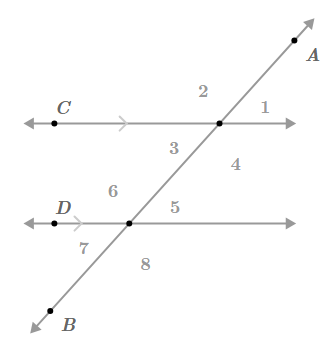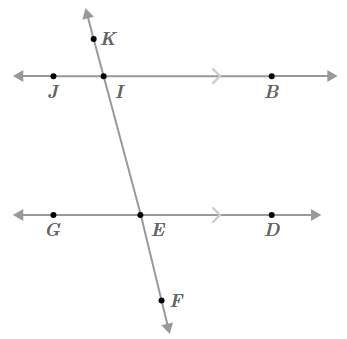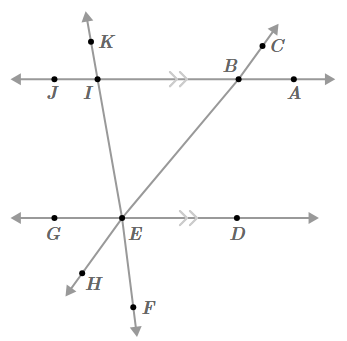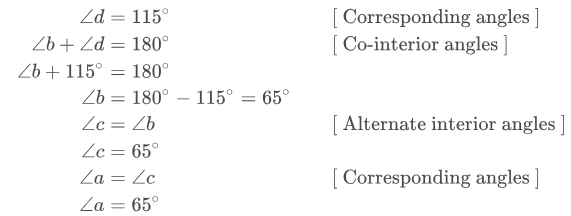Session 7: What are Parallel Lines? – Transversal, Properties, Angles, Interactives and Examples
The map shows the grid of some of the streets in Bengaluru. What angles are formed whenever two parallel streets, 10th A Main Road and 10th Main Road, intersect by Double Road?
What are Intersecting Lines?
Two or more lines are intersecting when they cross or meet each other at a single point.
The common point where all the intersecting lines meet is called the point of intersection. The two lines \(\overleftrightarrow{AB}\) and \(\overleftrightarrow{CD}\) intersect each other at point O.

What are Parallel Lines?
Two or more lines are parallel when they lie in the same plane and never intersect. The symbol for parallel is ∥. To mark parallel lines, draw arrows (>) on each parallel line. If there are more than one pair of parallel lines, use two arrows (>>) for the second pair. The two lines below would be labelled \(\overleftrightarrow{AB}\)∥\(\overleftrightarrow{MN}\) or l∥m.
- The perpendicular distance between two parallel lines is equal everywhere.
- If two lines lie in the same plane and are perpendicular to the same line, then they are parallel to each other.
- If two lines are parallel to the same line, then they are parallel to each other.
- One and only one parallel line can be drawn to a given line through a given point that is not on the given line.
As long as the lines or rays intersect, at least one angle will be formed. If the lines (or rays) are parallel, and therefore don’t intersect, then no angles will be formed.

What is a Transversal?
The word ‘transverse’ means ‘cuts across something’, and transversal is a line that intersects given lines at distinct points.
In diagram (i), line t is a transversal to the lines l,m and n because it intersects them at different points A, B and C, respectively. But in (ii), line p is not a transversal because it cuts both the lines q and r at the same point O.
Angles Formed by a Transversal with Two Lines
When a transversal intersects two given lines at distinct points, then eight angles are formed, four angles at each intersecting point. Let us study these angles in detail.
- Corresponding angles are called that because their locations correspond: they are formed on different lines but in the same position. They are pairs of nonadjacent angles, one of which is an interior and the other one exterior, both on the same side of the transversal. Examples of corresponding angle pairs are ∠1 and ∠5, ∠2 and ∠6, ∠3 and ∠7, and ∠4 and ∠8.
- Same side interior angles (sometimes called co-interior angles) are on the interior of the figure (between the lines) and on the same side of the transversal. The same side interior angle pairs in this figure are ∠4 and ∠5, and ∠3 and ∠6.
- Alternate interior angles are also on the interior of the figure but on opposite sides of the transversal. The alternate interior angle pairs here are ∠3 and ∠5, and ∠4 and ∠6.
- Alternate exterior angles are on the exterior of the figure (above and below the lines), but on opposite sides of the transversal. The alternate interior angle pairs are ∠1 and ∠7, and ∠2 and ∠8.
- Same side exterior angles (sometimes called co-exterior angles) are on the exterior of the figure (between the lines) and on the same side of the transversal. The same side exterior angle pairs in this figure are ∠1 and ∠8, and ∠2 and ∠7.
Angles formed by a Transversal with Parallel Lines
When two lines are cut by a transversal, many different angle pairs are formed. If the two lines are parallel, these angle pairs have special properties.

- ∠1 and ∠5 are corresponding angles because their locations are corresponding. If lines are parallel, then corresponding angles are congruent. Other examples of corresponding angles are ∠2 and ∠6, ∠3 and ∠7, and ∠4 and ∠8.
- ∠4 and ∠5 are same side interior angles because they are inside the lines and on the same side of the transversal. If lines are parallel, then the same side interior angles are supplementary. Another example of same side interior angles is ∠3 and ∠6.
- ∠3 and ∠5 are alternate interior angles because they are inside the lines and on opposite sides of the transversal. If lines are parallel, then alternate interior angles are congruent. Another example of alternate interior angles is ∠4 and ∠6.
- ∠1 and ∠7 are alternate exterior angles. If lines are parallel, then alternate exterior angles are congruent. Another example of alternate exterior angles is ∠2 and ∠8.
- ∠2 and ∠7 are same side exterior angles. If lines are parallel, then the same side exterior angles are supplementary. Another example of same side exterior angles is ∠1 and ∠8.
Thus, we can conclude that when a transversal intersects parallel lines, then:
- The corresponding angles are congruent (equal).
- The alternate angles are congruent (equal).
- The sum of interior or exterior angles on the same side of the transversal is 180∘.
Note: If any of the above three conditions are satisfied when a transversal intersects two lines, then the two lines are said to be parallel.
| DID YOU KNOW? The Lakota are a Native American tribe. Lakota women are known for their quillwork and beadwork. They tend to work with beads using the stitch entitled the “lazy-stitch”. The beadwork is centrally focused on geometric shapes and lines.  |
The map of Bengaluru above shows that the streets 10th A Main Road and 10th Main Road are parallel to one another. The numbered streets shown on this map are intersected by Double Road. The angles formed by the intersection of Double Road with 10th A Main Road and 10th Main Road (shown on the map) are equal because they are corresponding angles. Similar results could be found for the angles formed by the intersection of the 6th crossroad with 10th A Main Road and 10th Main Road.
Parallel Lines and Transversal – Examples
Example 1

If m∠KIB=105∘, what is m∠DEI ?
m∠DEI=105∘ because it is a corresponding angle with ∠KIB and corresponding angles are congruent (equal) when lines are parallel (note that the > markings indicate that the lines are parallel).
Example 2
In the diagram below, m∠KIJ=80∘. Find m∠GEI.

m∠GEI=80∘because it is a corresponding angle with ∠KIJ and corresponding angles are congruent (equal) when lines are parallel.
Example 3
In the figure below, l∥m. Find the measure of angles a,b,c and d.
It is given that l∥m and n is the transversal.

Example 4
Check whether line � is parallel to line � or not.
Given that m and n are two lines and t is a transversal.
123∘ and 55∘ are angles on the same side of the transversal. Let us find the sum of these co-exterior angles.
123∘+55∘=178∘≠180∘Since the sum of co-exterior angles is not 180∘; the lines are not parallel. Thus, line m is not parallel to line n.

Remember this!
- A line intersecting two or more distinct lines at distinct points is called a transversal.
- Two angles are said to be a pair of corresponding angles if they are on the same side of the transversal with one angle interior and the other angle exterior, and the angles are not adjacent.
- Two angles are said to be co-interior angles if they are interior angles and lie on the same side of the transversal.
- Two angles are said to be co-exterior angles if they are exterior angles and lie on the same side of the transversal.
- Alternate interior angles are said to be a pair of alternate angles if the angles are interior angles, which lie on either side of the transversal and are not adjacent.
- Alternate exterior angles are said to be a pair of alternate angles if the angles are exterior angles, which lie on either side of the transversal and are not adjacent.






